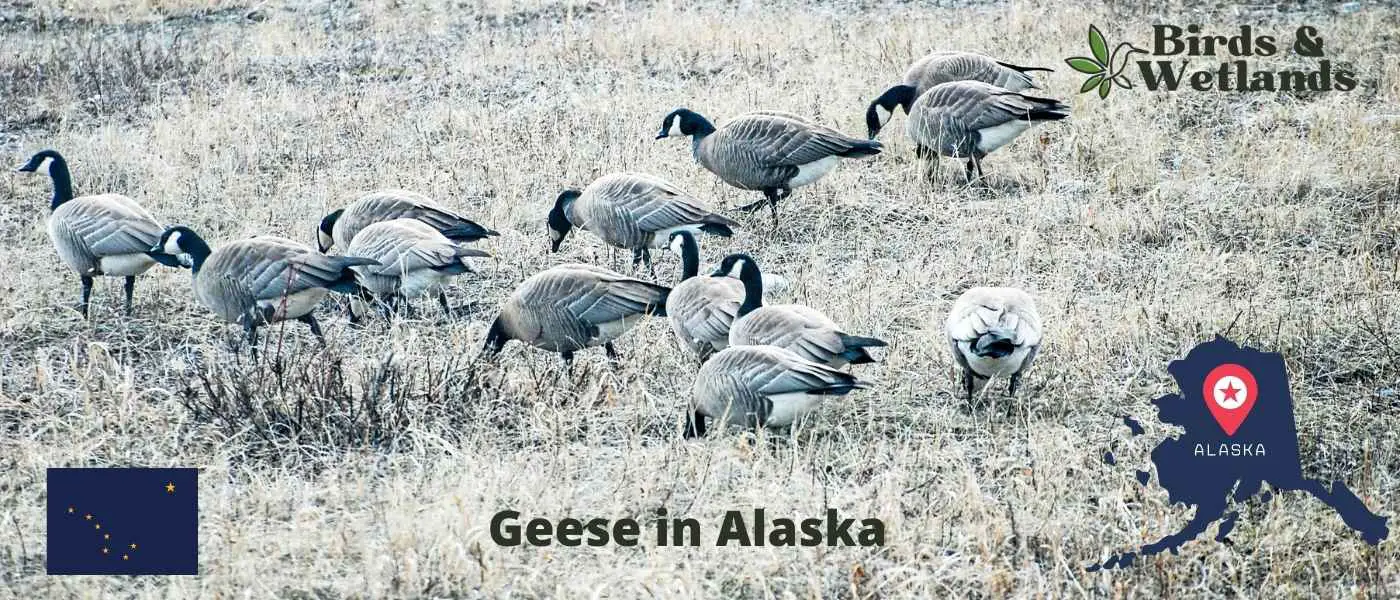This comprehensive guide will teach you everything you need to know about Geese in Alaska from the types to their biology, behavior, and ecology. We will cover topics such as where to find them, what they eat, and how to identify different species. So if you’re interested in learning more about all the different geese in Alaska, read on!
Do geese live in Alaska?
There are six different species of North American geese that can be found in the state: Canada goose, white-fronted goose, brant, snow goose (or lesser snow goose), cackling goose and the emperor goose, according to the state department. Each species has a different appearance and range, but all can be found in Alaska.
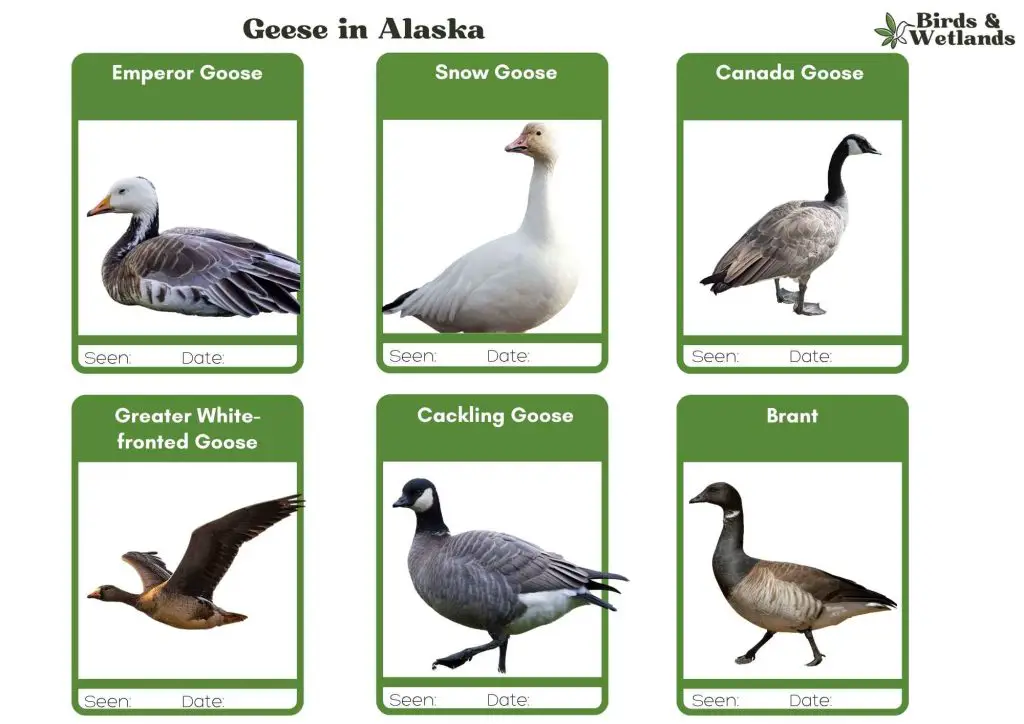
Brant
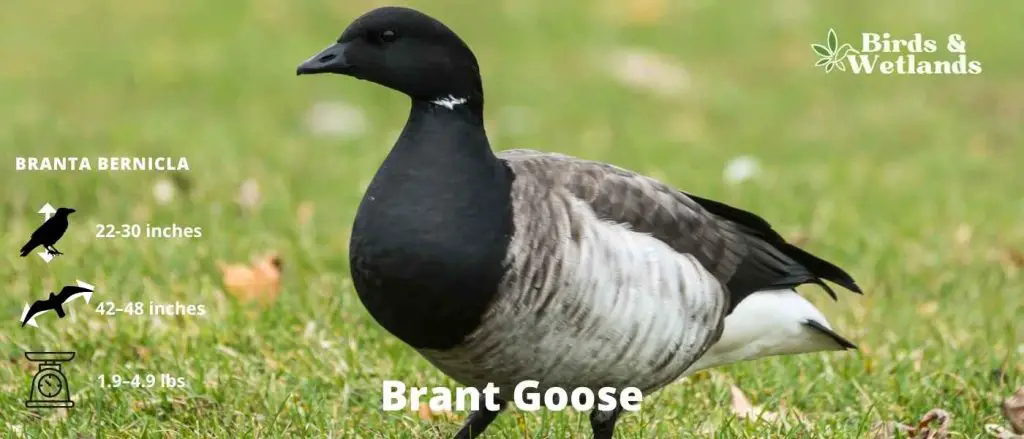
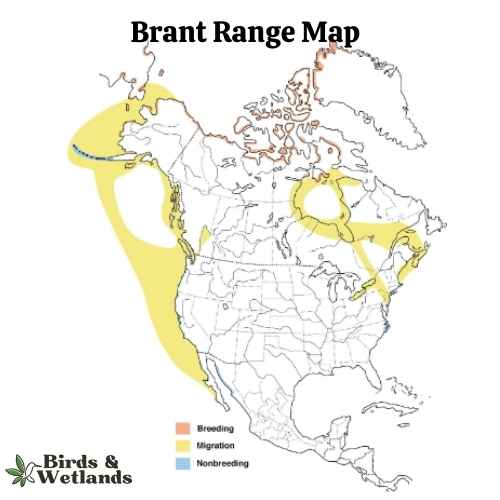
Listen
Scientific Name: Branta bernicla
Length: 22–26 in
Wingspan: 42–48 in
Weight: 1.9–4.9 lb
The Brant is a compact species of goose that is known for its striking appearance and interesting migratory patterns.
Appearance: The Brant is recognized for its dark, sooty color with a white crescent on the neck. The body is mostly black to dark gray, contrasting with the lighter underparts. Its small size, as compared to other geese, and short, stubby bill are other distinct features.
Diet: The Brant’s diet primarily consists of aquatic plants, especially eelgrass and sea lettuce. During the breeding season, they may also feed on grasses, sedges, and insects.
Reproduction: Brants typically breed in the high Arctic tundra. The female lays a clutch of 3 to 5 eggs in a ground nest, which she incubates for about a month.
Notably, Brants make an impressive long-distance migration every year. They spend their winters along both the east and west coasts of the United States and travel to the Arctic regions of Canada, Alaska, and even Russia to breed.
Brant in Alaska
The brant goose is a migratory bird that when it’s time to nest, Pacific brant fly south in colonies along the Yukon-Kuskokwim Delta Coast. These birds also spread out across other areas like Alaska and Canada while they’re here for six – nine weeks during fall season!
The population of Pacific brant geese in Alaska is carefully monitored and managed. Due to their dependence on specific breeding and wintering habitats, conservation efforts aim to protect these critical areas and ensure the long-term survival of the brant population.
Greater White-fronted Goose
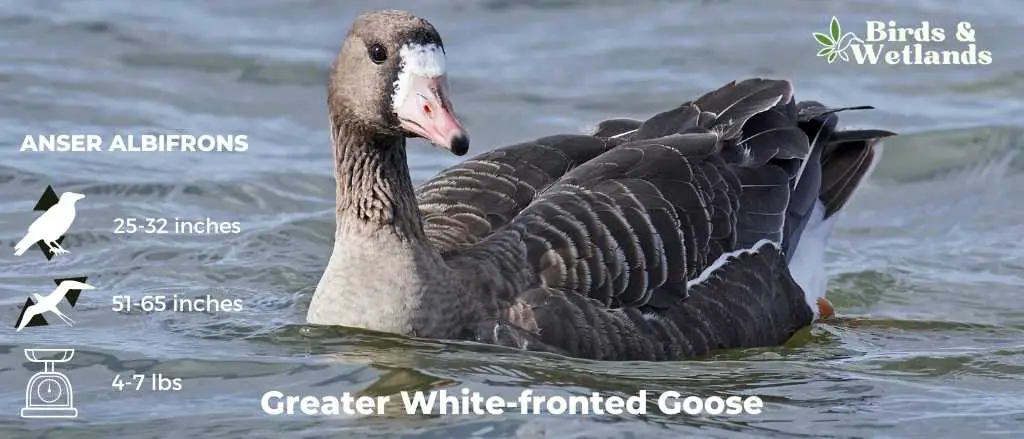
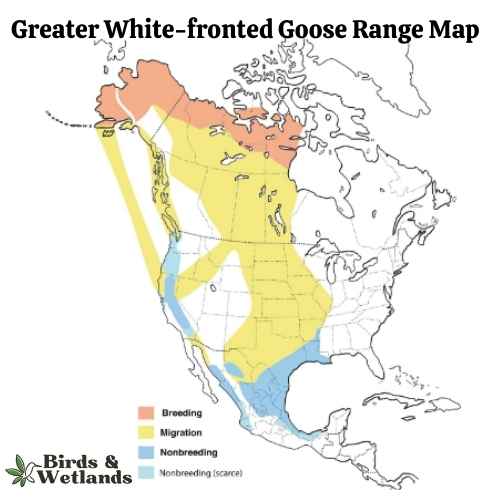
Listen
Scientific Name: Anser albifrons
Length: 25 to 31 in
Wingspan: 53 to 66 in
Weight: 3.3 to 6.6
The Greater White-fronted Goose is a medium to large waterfowl species, widely distributed across the Northern Hemisphere, particularly in North America.
Appearance: As the name suggests, these geese display a prominent white patch at the base of their bill. Their bodies are gray-brown, and their breasts are often marked with dark blotches. They possess a pinkish bill and orange legs and feet.
Diet: The Greater White-fronted Goose is a herbivore and feeds mainly on plant material. Its diet consists of grasses, sedges, grains, and berries. When wintering, these geese can often be found in agricultural fields, feasting on leftover grains and crops.
Reproduction: This species nests on the ground, often in areas with good visibility such as slopes or ridges. The female lays a clutch of 4 to 5 eggs, which she incubates for nearly a month. Once hatched, the young ones are taken care of by both parents until they are able to fly.
Snow Goose
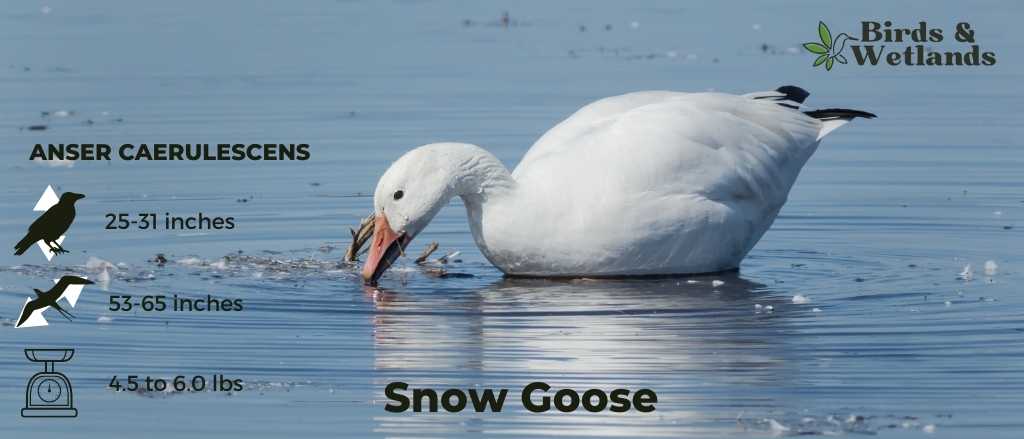
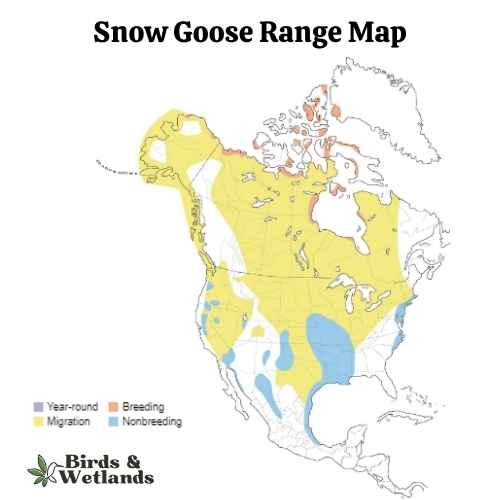
Snow Goose Sound
Scientific Name: Anser caerulescens
Length: 25 to 31 in
Wingspan: 53 to 65 in
Weight: 4.5 to 6.0
The Snow Goose is a large species of waterfowl known for its vibrant white plumage and significant migratory flights.
Appearance: True to their name, Snow Geese are predominantly white with black wingtips. They also have a pink bill, pink legs and feet. A color morph, known as the “Blue Goose,” displays a bluish-gray body with a white head, but is considered the same species.
Diet: Snow Geese primarily feed on plant matter, such as grasses, sedges, and small grains. They can often be seen in large flocks foraging in fields and marshes, and during migration and winter, they can cause considerable damage to agricultural fields due to their feeding habits.
Reproduction: Snow Geese typically nest on the tundra, near water bodies. The female builds the nest and lays a clutch of about 3 to 5 eggs, which she incubates alone for approximately three weeks. Once hatched, the goslings can feed themselves but stay with their parents for protection until they can fly.
Snow Geese in Alaska
Snow geese can be seen most at the Copper river delta, there are not many nesting pairs in Alaska, the few breeding birds are are on Howe Island, near Prudhoe Bay, the Spring migration starts in April, when large flocks start their journey south to their breeding grounds, often stopping off in the Matanuska valley.
The sheer volumes of Snow Geese in Alaska, is beginning to cause some issues, as they are growing with a 5-8% growth rate despite liberal hunting laws and no bag limits. This is leading to habitat degradation which will need to be addressed soon.
Do snow geese breed in Alaska?
No, the Snow Goose does not breed in Alaska. Snow Geese breed in the Arctic regions of Canada and Alaska’s neighboring state, Russia. During the breeding season, they nest in the tundra areas of the northern regions. However, Alaska serves as an important stopover and wintering ground for Snow Geese during their migration.
Emperor Goose
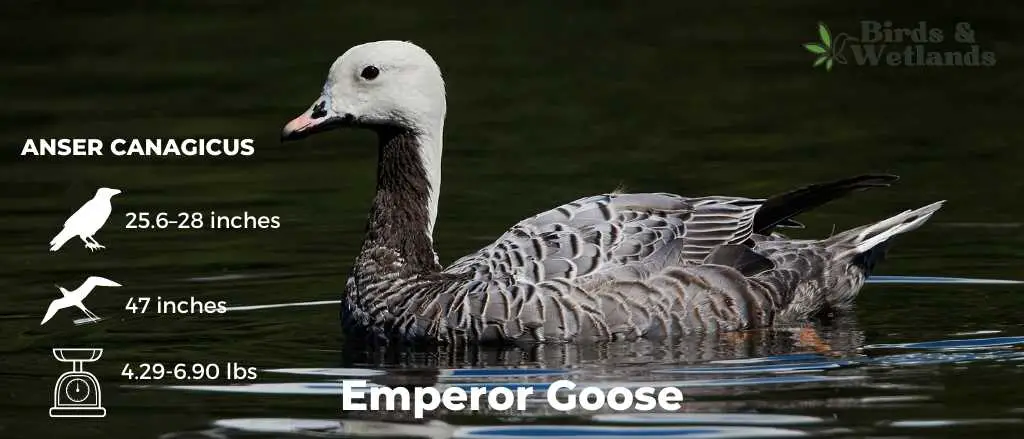
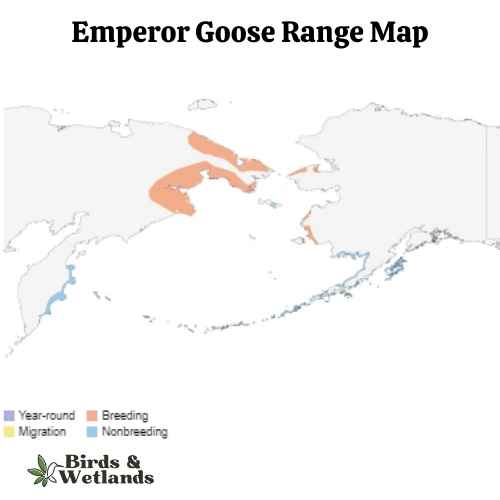
Listen:
Scientific Name: Anser canagicus
Length: 26–28 inches
Wingspan: 47 in
Weight: 4.29 lb
The Emperor Goose, also known as the beach goose or the painted goose, is one of the rarest geese in North America, and one that every birdwatcher hopes to see. This small and stocky goose is only found in Alaska. They are large birds with a wingspan of up to 4 feet and feed on the small plants in the mud at the edges of lakes and rivers, as well as roots and seeds.
The plumage is overall silvery gray, with a black and white margins making it look scaled. With a white head (which can become rust colored in the summer months), it has a black throat and its bill is small and pinkk, and the legs are orange. The sexes are similar, but juveniles have a duller plumage being gray all over.
Emperor geese need large tracts of land with patchy vegetation, water, and ample food to survive. Emperor geese use their bills to catch fish (and occasionally small mammals) while swimming in the water or flying over it. They thrive in wetland habitats because they provide the birds with food and protection from predators such as bears and wolves.
Female emperor geese lay 3-8 eggs per season in a nest made from grasses and plant material. She does the majority of incubation of the eggs, which take about 30 days to hatch.
Emperor Geese nest in Alaska in a small area along the Yukon-Kuskokwim Delta coast or in early spring on Kodiak Island. They like the rocky beaches and brackish wetlands where they can feed on eelgrass and sea lettuce. Female emperor geese will have one partner throughout their life, unless that partner dies.
Canada Goose
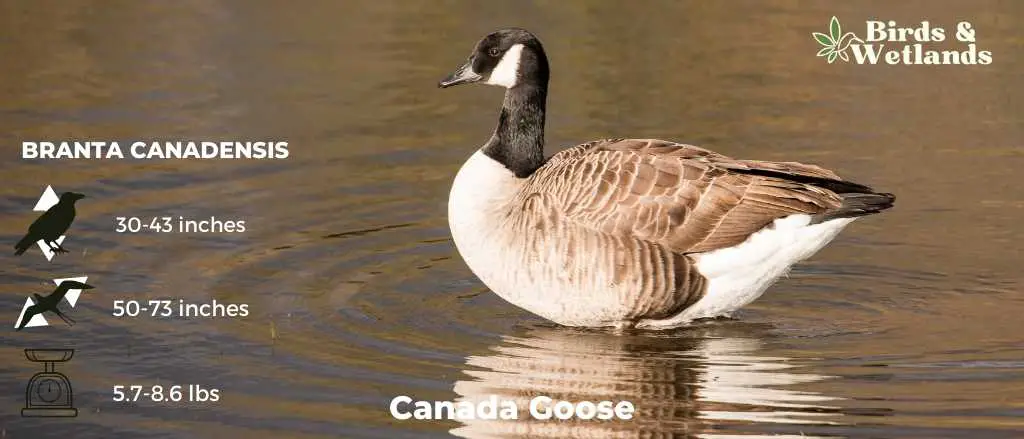
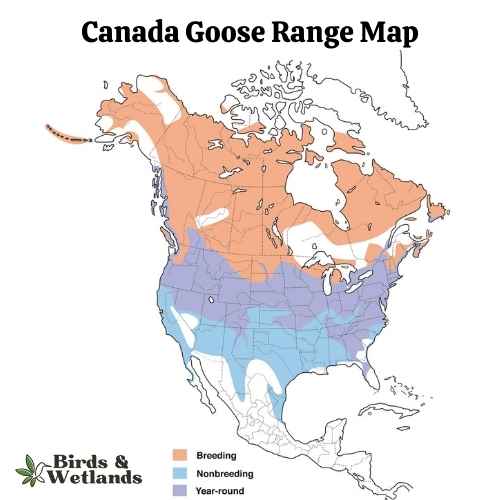
Canada Goose Sound
Scientific Name: Branta canadensis
Length: 30 to 43 in
Wingspan: 50–73 in
Weight: 5.7–14.3 lb
The Canada Goose is a large, well-known species of waterfowl noted for its distinctive appearance, familiar “honk,” and migratory behavior.
Appearance: Both male and female Canada Geese have a similar appearance, featuring a black head and neck with distinctive white patches on the cheeks and chin. The body is primarily brown with a lighter, often white, underbelly.
Diet: Canada Geese primarily feed on plant matter, including grasses, aquatic vegetation, and grains. They can often be seen grazing in parks, lawns, and fields, as well as dabbling in water bodies.
Reproduction: Canada Geese typically nest on the ground near water bodies, often on islands or other isolated areas to avoid predators. The female lays a clutch of about 4 to 6 eggs, which she incubates alone for around a month.
A sub species of the Canada goose is the Giant Canada Goose. The Canada Geese have very high resident flocks in Alaska, and the Alaska department of Fish and Game, in partnership with the US wildlife service have worked hard to reduce their numbers.
Cackling Goose
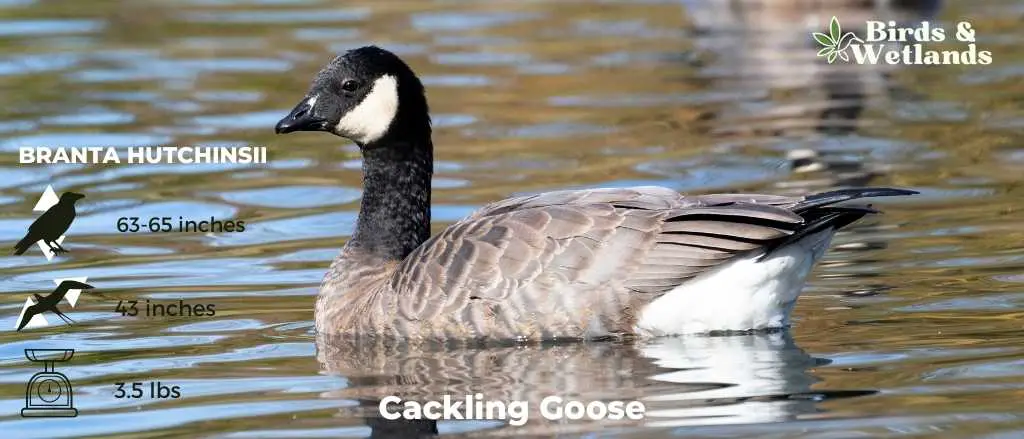
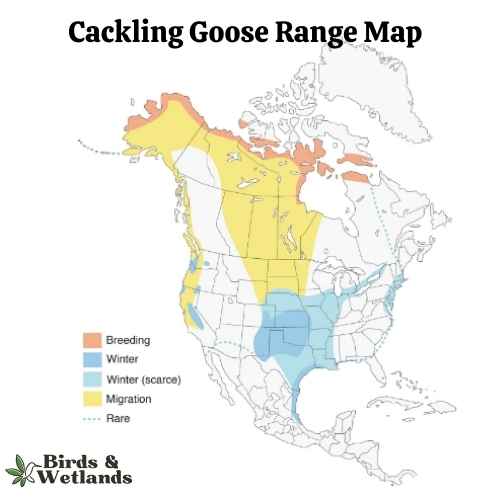
Listen
Scientific Name: Branta hutchinsii
Length: 24.8–25.6 in
Wingspan: 43-45.7 in
Weight:3.5 lbs
Cackling Geese are particularly known for their high-pitched, cackling calls, which is the source of their name. Despite their small size, these geese are renowned long-distance migrants, with some populations traveling thousands of miles between breeding and wintering grounds.
Appearance: With a similar color pattern to the larger Canada Goose, the Cackling Goose features a black head and neck, white chinstrap, light tan to cream chest, and brownish-grey body. One defining characteristic is its noticeably smaller size and stubbier neck compared to its larger counterparts.
Diet: Like many geese, the Cackling Goose’s diet mainly consists of plant matter. This includes grasses, seeds, and aquatic vegetation. They are often seen grazing on land or dabbling in shallow water.
Reproduction: Cackling Geese usually nest on the ground in elevated areas near water bodies, such as riverbanks or lakeshores. The female lays a clutch of 2 to 8 eggs and is responsible for incubation, while the male stands guard nearby. Incubation lasts for about a month.
Where to Spot Alaska’s Geese
These locations in Alaska provide prime opportunities for spotting a wide range of geese species and other water birds in Alaska, amidst the state’s stunning natural landscapes and inland lakes.
Copper River Delta: Located on the Gulf of Alaska, the Copper River Delta is a vast and pristine wetland complex. It serves as a crucial stopover and breeding ground for a wide variety of waterfowl, including various species of geese.
Minto Flats State Game Refuge: Situated in the central part of the state, Minto Flats is a vast wetland area that attracts a rich assortment of birdlife. It is home to numerous waterfowl species, including several types of geese.
Kachemak Bay: Near Homer, Alaska, Kachemak Bay is a scenic coastal area renowned for its diverse bird populations. Geese, along with other waterfowl, frequent the bay’s wetlands, estuaries, and shorelines.
Kenai Peninsula: The Kenai Peninsula offers various habitats, including coastal areas, lakes, and rivers, which are favored by geese. Locations such as Kenai National Wildlife Refuge and the Kenai River provide excellent opportunities for observing a variety of geese species.
Yukon-Kuskokwim Delta: The Yukon-Kuskokwim Delta is a vast coastal plain in western Alaska. It is a significant breeding ground for waterfowl, including various geese species. The delta’s wetlands and tundra support a rich ecosystem that attracts diverse birdlife.
There is a healthy population of goose species and other water birds in Alaska, however both the snow Goose and Canada goose populations are causing some habitat issues. Even with no bag limits for hunters, these resident populations are growing in many areas.

